Feeling refreshed after several days in the countryside, it was time for us to move on to visit a few of Argentina’s northern cities. On April 26, we said goodbye to our rock dog friend and traveled to Mendoza to catch an overnight bus to Cordoba. However, we had several hours to kill before our 10 PM bus, so what better way than to wine taste? We found a wine shop that offered tasting flights and enjoyed tasting some more of the area’s fabulous wines.
Cordoba is Argentina’s second largest city and has seven universities. It is well known for its historic churches and Jesuit square. After our early morning arrival, we set out to explore the city’s center. Plazas are a staple in every Argentine city, and Cordoba’s was beautiful with a big statue of San Martin in the center and the beautiful Cordoba cathedral dominating the square. The cathedral took 200 years to complete after starting in 1577 and is a mixture of Jesuit and Franciscan design.
Cordoba’s Manzana Jesuitica is an entire block of Jesuit buildings with pedestrian-only streets. The buildings were pretty, and since it was Friday there were musicians playing and lots of people out and about. The Iglesia de la Compania de Jesus was the church on this block and was built in 1671. The designer was a boat builder, so the inside of the church’s ceiling looked like an upside down boat’s hull. It was made of cedar, so the church had a pleasant smell. The altarpiece was also carved cedar with life-size figures of saints. Behind the cathedral, was a small chapel, Capilla Domestica, which was built in 1644. The ceiling was made of cowhide stretched out and painted with pigments made of bones. It was a beautiful design.
                                                 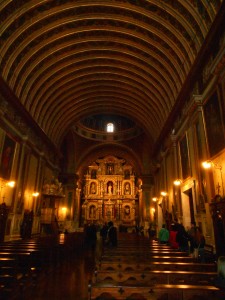
We continued our tour of Cordoba’s churches by visiting Parroquia Sagrado Corazon de Jesus de los Capuchinos (long name!). It was built in 1934 in a neo-gothic style. The outside is missing a steeple in order to symbolize human imperfection, and there are sculptures of Atlas holding up saints to symbolize him holding up the sins of the world.
Our last sight of the day was Palacio Ferrerya, a 1914 mansion, that housed an art museum. There were a few pretty pieces of impressionist works, but for the most part it was modern art, which doesn’t intrigue Mike nor I. So instead, I looked at the pretty architecture of the building.
The next day, we hopped a mini-bus to Alta Gracia. Alta Gracia is a small city 30 minutes from Cordoba and is home to a Jesuit church and Che Guevara’s childhood home. We toured the Jesuit museum which was originally the living and working space of the compound built in 1643. Each room had some historical pieces of furniture and a nice explanation of the settlement’s history. Unfortunately, the interior of the church was closed.
                                                  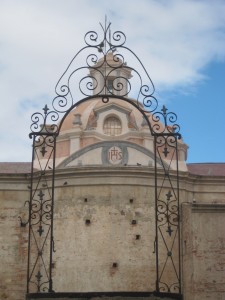
The Che Guevara museum was informative with lots of childhood pictures throughout the house. One of the displays was his old motorcycle and bicycle. There was a map of his travels through Latin America from each trip. Fidel Castrol visited the museum in 2006 and there were lots of pictures of his visit displayed. Neither of us are particularly impressed by his legend, but it was still a unique place to visit.
 Back in Salta, we spent the evening in the artisan neighborhood of Guemes at their weekend art fair. There were many stalls of varied crafts. We both really liked the colorful, stone sculpted clocks, but neither of us were up to carrying it around for our remaining two months. The knitwear was also fabulous and made out of llama wool. It was fun to look around .
Sundays in an Argentine city are quiet, so quiet you wonder if anyone lives or works there. All of the shops are closed all day with the exception of a few snack stores and some of the restaurants are closed too. So, we had an entire Sunday to spend in Cordoba before a night bus to Salta. We spent the time in catching up in our journals in cafes and wandering the streets. The one museum that was open was Museo Muncipal de Bellas Artes Dr. Genaro Perez. The building was a beautiful mansion with gorgeous wood floors and fireplaces. In back there was a lovely sunroom with multi-colored glass. I had way more interest in the building than the modern art pieces, which included a huge sandbox and a florescent light display which flicked on and off symbolizing the human brain. Mike and I didn’t get it, but at least we did something for our last day in Cordoba!
                                        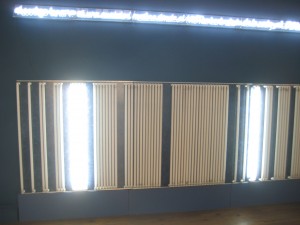
I woke up to our descent into Salta which is located in a valley full of lush, green trees surrounded by tall mountains. Our first destination was the Bolivian embassy to get our visas, but it was closed, and we later found out it would be closed until Wednesday due to Labor Day on May 1st. Strike one with our Bolivian visa. Since it was a holiday, Salta’s main square and pedestrian shopping streets were packed. It added a nice sense of vibrancy, especially after the desolate roads of Cordoba the day prior.
Our church tour continued in Salta with the Inlgesia San Francisco, which had a very colorful façade and a slim bell tower. The inside had beautiful stain glass windows and a pretty painted ceiling. Salta’s main cathedral towers in pink over the town square. It was built in 1878 and had a very ornate, baroque altarpiece.
 We were churched out so we headed to the Museo de Arqueologia de Alta Montana (MAAM). The museum was built to display Incan artifacts and mummies that were found in 1999 on nearby Mt. Llullaillaco, a 6,739 m peak. The Inca’s used to perform human sacrifices to please the gods and usually preformed them on high peaks, which the Inca’s considered sacred. Three bodies and many burial art pieces were found well-preserved from the elements due to the elevation (6700m). The children were from noble families and taken to Cuzco (the sacred city) for a festival and symbolic marriage uniting the different regions of the Inca empire. Then they pilgrimaged to the peak were the children were fed an alcoholic maize drink to make them fall asleep, and then they were put to their final resting place.
The 3 children were found in a sitting position, and all of their clothes are perfectly preserved. The boy (age 7) was on display, so we could see his white feather headdress. It was remarkable how well he was preserved as he just looked like he was sleeping. The other 2 children were girls and were not on display but they did have pictures. They were named “girl of lightening†(age 6 and at some point struck by lighting) and “the maiden†(age 15).
Small dolls with gold and silver faces were buried next to the children and also small rock carved llamas. They were so intricate and beautiful. I really enjoyed this museum and am looking forward to our continued travel through the Incan empire for the remainder of our trip.
Labor Day (May 1st) was a restful day for Mike and I as nothing was open in the city. Our B&B had an amazing breakfast and a very comfortable room to spend our day catching up on journals and emails. We also called our parents, and it was nice to get the news from home and tell a few stories. I caught up on some TV action, including my favorite show, Grey’s Anatomy. They even had a few episodes from this season! So really, we didn’t do much, but it was a nice treat to take it easy for the day.
Our next stop was Cafayate, a small town 4 hours south of Salta. We had delayed traveling there by 1 day due to Labor day so that we could get our Bolivian visas, so our first task of the day was the Bolivian consulate. We arrived, and it was busy. We waited at the counter, and the women ignored us and helped 2 other people who came in after us. Finally, a lady helped us and took our paper work, but a few minutes later our paperwork was returned, and we were told that they only could help Bolivian citizens! Strike 2 for our Bolivian visa.
Our 4 hour bus ride took us through the breathtaking Quebrada de Cafayate. It was a valley with brilliant red hillsides on each side of us. The town of Cafayete was quaint with a lively town square and quiet streets as most of the locals rode bicycles. The town is known for 2 things… amazing wine and scenery. Sounded like the perfect way to spend a few days after the bustle of city life.
On May 3rd, Mike and I rented bicycles to tour the nearby wineries. Cafayate is at 1700 m and claims to have the world’s highest vineyards. The hot days and cold nights intensify both the flavor and aromas of the wines. The local specialty is Torrentes, which is only grown in Argentina . It is knick named “the cheater wine†because it has a floral, sweet smell but dry flavor, and it has a high alcohol content so may take you by surprise after a few glasses.
Our favorite winery of the day was Bodega de las Nubes, which was set above town right at the edge of the mountains. It was one of the most scenic wineries and had some amazing wine. It is a boutique winery and only produces one bottle per vine!
After wine tasting, we returned our bikes but not before Mike realized he lost the key to the bike lock. Luckily, it was cheap to replace, but I now think that we have a 3 to 1 ratio of things lost between Mike and IJ
We finished the day by touring the wine museum. It was bad and was really more of an advertisement than a museum for the world’s best wine. The wine was good, but not that good! The walls were plastered with bad wine poetry; well, maybe it sounded better in Spanish. There were some interesting historical wine making tools, but overall a waste of our money.
Our hotel was run by a cute husband and wife with an adorable, curly head son. The rooms were set up around the family’s garden courtyard and was lovely. They were also amazing hosts as the next day we had a 6 AM bus to Quilmes, and the husband woke up at 5:30 to feed us breakfast!
Quilmes is a ruined city occupied by the indigenous people from 1000 to 1667. The city held off the Incas and, after 130 years of war, finally fell to the Spaniards. At its peak, the city housed 10,000 people. The city was built into the hillside with lookouts on both sides that had amazing views of the surrounding valley.
We arrived in the dark for the 5km walk from the highway to the ruins. The sunrise was fantastic with purples and pinks and setoff prettily by the cactus. We arrived at the ruins before it really opened, so we had the entire city to ourselves to explore. The house walls were stones and 3 feet thick. It was fun to look around, especially with views from above to see the entire complex. Throughout the ruins were the remains of the mortars used by the community. In the center was a large building that was the meeting place and religious center. Mike and I really had fun walking around by ourselves and figuring out what the buildings were used for and what daily life must have been like.
Mike and I spent the remainder of the day chilling out at our hotel. We indulged in a fancy dinner where Mike tried llama steak, and we shared a great bottle of local wine. Cafayate was one of our favorite places in Argentina. It had just the right mix of rural quiet but also a few things to do.
With less than 2 months to go on our trip abroad, we are still enjoying ourselves. We are feeling a bit run down and have both suffered colds and the flu in Argentina but we love the adventures and the day to day new things. We definitely enjoy the rural towns more than the big cities. The landscapes in Argentina have been magnificent, and we are excited to see more!
**Sorry there are not more pictures… the connection is really slow and I have spent 3 hours trying to get these pictures uploaded!

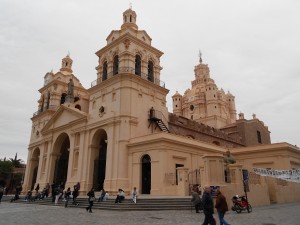
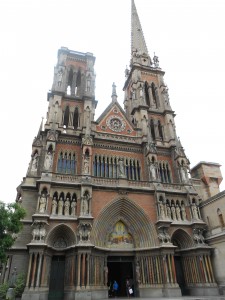



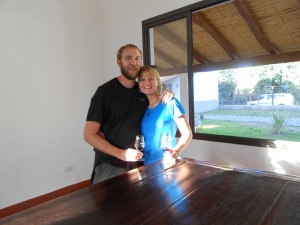
Nice to read about your Argentine adventures… we got stuck in Salta for 4 days ourselves. So, we decided one day to go bungee jumping! We also did a wine tour there. You can’t go wrong with Argentina and wine 🙂
PS- relaxing “chill” days are awesome!